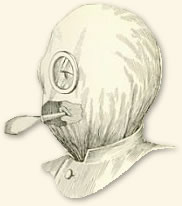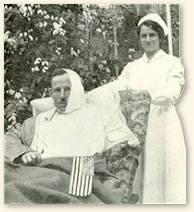|
Gas Attack, 1916
The First World War accelerated the development of new technologies designed to improve the ability to kill an enemy: the machine gun, the tank, the airplane, the zeppelin, and gas to name a few. Among these, gas was probably the crudest, certainly the
 |
French gas attack on German lines
Belgium, 1916
|
most capricious - a change in wind direction could spell disaster. Initially, gas cylinders were simply placed along the front lines facing the enemy trenches. Once the wind was deemed favorable, the cylinders were opened and the gas floated with the breeze, carrying death to the enemy. Later, gas was packed into artillery shells and delivered behind enemy lines. No matter the method of delivery, its impact could produce hell on earth. Chlorine and phosgene gases attacked the lungs ripping the very breath out of its victims. Mustard gas was worse. At least a respirator provided some defense against the chlorine and phosgene gases. Mustard gas attacked the skin - moist skin such as the eyes, armpits, and groin. It burned its way into its victim leaving searing blisters and unimaginable pain.
First introduced by the Germans, gas warfare was soon embraced by all the combatants. By the end of the war, one in four of the artillery shells fired on the Western Front contained gas.
Arthur Empey was an American living in New Jersey when war consumed Europe in 1914. Enraged by the sinking of the Lusitania and loss of the lives of American passengers, he expected to join an American army to combat the Germans. When America did not immediately declare war, Empey boarded a ship to England, enlisted in the British Army (a violation of our neutrality law, but no one seemd to mind) and was soon manning a trench on the front lines.
Emprey survived his experience and published his recollections in 1917. We join his story after he has been made a member of a machine gun crew and sits in a British trench peering towards German lines. Conditions are perfect for an enemy gas attack - a slight breeze blowing from the enemy's direction - and the warning has been passed along to be on the lookout:
"We had a new man at the periscope, on this afternoon in question; I was sitting on the fire step, cleaning my rifle, when he called out to me:
'There's a sort of greenish, yellow cloud rolling along the ground out in front, it's coming ---'
But I waited for no more, grabbing my bayonet, which was detached from the rifle, I gave the alarm by banging an empty shell case, which was hanging near the periscope. At the same instant, gongs started ringing down the trench, the signal for Tommy to don his respirator, or smoke helmet, as we call it.
Gas travels quietly, so you must not lose any time; you generally have about eighteen or twenty seconds in which to adjust your gas helmet.
A gas helmet is made of cloth, treated with chemicals. There are two windows, or glass eyes, in it, through which you can see. Inside there is a rubber-covered tube, which goes in the mouth. You breathe through your nose; the gas, passing through the cloth helmet, is neutralized by the action of the chemicals. The foul air is exhaled through the tube in the mouth, this tube being so constructed that it prevents the inhaling of the outside air or gas. One helmet is good for five hours of the strongest gas. Each Tommy carries two of them slung around his shoulder in a waterproof canvas bag. He must wear this bag at all times, even while sleeping. To change a defective helmet, you take out the new one, hold your breath, pull the old one off, placing the new one over your head, tucking in the loose ends under the collar of your tunic.
For a minute, pandemonium reigned in our trench, - Tommies adjusting their helmets, bombers running here and there, and men turning out of the dugouts with fixed bayonets, to man the fire step.
Reinforcements were pouring out of the communication trenches.
Our gun's crew was busy mounting the machine gun on the parapet and bringing up extra ammunition from the dugout.
"Too slow getting on
his helmet"
|
German gas is heavier than air and soon fills the trenches and dugouts, where it has been known to lurk for two or three days, until the air is purified by means of large chemical sprayers. We had to work quickly, as Fritz generally follows the gas with an infantry attack. A company man on our right was too slow in getting on his helmet; he sank to the ground, clutching at his throat, and after a few spasmodic twistings, went West (died). It was horrible to see him die, but we were powerless to help him. In the corner of a traverse, a little, muddy cur dog, one of the company's pets, was lying dead, with his two paws over his nose.
 |
British Gas Helmet, 1916
|
It's the animals that suffer the most, the horses, mules, cattle, dogs, cats, and rats, they having no helmets to save them. Tommy does not sympathize with rats in a gas attack.
At times, gas has been known to travel, with dire results, fifteen miles behind the lines.
A gas, or smoke helmet, as it is called, at the best is a vile-smelling thing, and it is not long before one gets a violent headache from wearing it.
Our eighteen-pounders were bursting in No Man's Land, in an effort, by the artillery, to disperse the gas clouds.
The fire step was lined with crouching men, bayonets fixed, and bombs near at hand to repel the expected attack.
Our artillery had put a barrage of curtain fire on the German lines, to try and break up their attack and keep back reinforcements.
I trained my machine gun on their trench and its bullets were raking the parapet.
Then over they came, bayonets glistening. In their respirators, which have a large snout in front, they looked like some horrible nightmare.
"Nothing could stop
that mad rush"
|
All along our trench, rifles and machine guns spoke, our shrapnel was bursting over their heads. They went down in heaps, but new ones took the place of the fallen. Nothing could stop that mad rush. The Germans reached our barbed wire, which had previously been demolished by their shells, then it was bomb against bomb, and the devil for all.
Suddenly, my head seemed to burst from a loud 'crack' in my ear. Then my head began to swim, throat got dry, and a heavy pressure on the lungs warned me that my helmet was leaking. Turning my gun over to No. 2, I changed helmets.
The trench started to wind like a snake, and sandbags appeared to be floating in the air. The noise was horrible; I sank onto the fire step, needles seemed to be pricking my flesh, then blackness.
I was awakened by one of my mates removing my smoke helmet. How delicious that cool, fresh air felt in my lungs.
A strong wind had arisen and dispersed the gas.
They told me that I had been 'out' for three hours; they thought I was dead.
 |
The author recovering from
wounds received at the Front
|
The attack had been repulsed after a hard fight. Twice the Germans had gained a foothold in our trench, but had been driven out by counter- attacks. The trench was filled with their dead and ours. Through a periscope, I counted eighteen dead Germans in our wire; they were a ghastly sight in their horrible-looking respirators.
I examined my first smoke helmet, a bullet had gone through it on the left side, just grazing my ear, the gas had penetrated through the hole made in the cloth.
Out of our crew of six, we lost two killed and two wounded.
That night we buried all of the dead, excepting those in No Man's Land. In death there is not much distinction, friend and foe are treated alike.
After the wind had dispersed the gas, the R. A. M. C. got busy with their chemical sprayers, spraying out the dugouts and low parts of the trenches to dissipate any fumes of the German gas which may have been lurking in same."
References:
Empey, Arthur Guy, Over The Top (1917); Lloyd, Alan, The War In The Trenches (1976).
How To Cite This Article:
"Gas Attack, 1916," EyeWitness to History, eyewitnesstohistory.com (1999).
|






